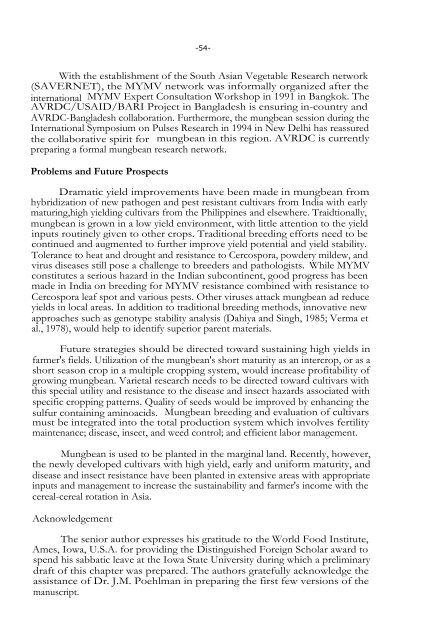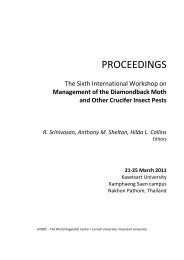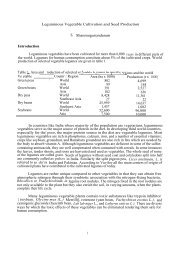MUNGBEAN VARIETAL IMPROVEMENT S. Shanmugasundaram
MUNGBEAN VARIETAL IMPROVEMENT S. Shanmugasundaram
MUNGBEAN VARIETAL IMPROVEMENT S. Shanmugasundaram
You also want an ePaper? Increase the reach of your titles
YUMPU automatically turns print PDFs into web optimized ePapers that Google loves.
-54-<br />
With the establishment of the South Asian Vegetable Research network<br />
(SAVERNET), the MYMV network was informally organized after the<br />
international MYMV Expert Consultation Workshop in 1991 in Bangkok. The<br />
AVRDC/USAID/BARI Project in Bangladesh is ensuring in-country and<br />
AVRDC-Bangladesh collaboration. Furthermore, the mungbean session during the<br />
International Symposium on Pulses Research in 1994 in New Delhi has reassured<br />
the collaborative spirit for mungbean in this region. AVRDC is currently<br />
preparing a formal mungbean research network.<br />
Problems and Future Prospects<br />
Dramatic yield improvements have been made in mungbean from<br />
hybridization of new pathogen and pest resistant cultivars from India with early<br />
maturing,high yielding cultivars from the Philippines and elsewhere. Traidtionally,<br />
mungbean is grown in a low yield environment, with little attention to the yield<br />
inputs routinely given to other crops. Traditional breeding efforts need to be<br />
continued and augmented to further improve yield potential and yield stability.<br />
Tolerance to heat and drought and resistance to Cercospora, powdery mildew, and<br />
virus diseases still pose a challenge to breeders and pathologists. While MYMV<br />
constitutes a serious hazard in the Indian subcontinent, good progress has been<br />
made in India on breeding for MYMV resistance combined with resistance to<br />
Cercospora leaf spot and various pests. Other viruses attack mungbean ad reduce<br />
yields in local areas. In addition to traditional breeding methods, innovative new<br />
approaches such as genotype stability analysis (Dahiya and Singh, 1985; Verma et<br />
al., 1978), would help to identify superior parent materials.<br />
Future strategies should be directed toward sustaining high yields in<br />
farmer's fields. Utilization of the mungbean's short maturity as an intercrop, or as a<br />
short season crop in a multiple cropping system, would increase profitability of<br />
growing mungbean. Varietal research needs to be directed toward cultivars with<br />
this special utility and resistance to the disease and insect hazards associated with<br />
specific cropping patterns. Quality of seeds would be improved by enhancing the<br />
sulfur containing aminoacids. Mungbean breeding and evaluation of cultivars<br />
must be integrated into the total production system which involves fertility<br />
maintenance; disease, insect, and weed control; and efficient labor management.<br />
Mungbean is used to be planted in the marginal land. Recently, however,<br />
the newly developed cultivars with high yield, early and uniform maturity, and<br />
disease and insect resistance have been planted in extensive areas with appropriate<br />
inputs and management to increase the sustainability and farmer's income with the<br />
cereal-cereal rotation in Asia.<br />
Acknowledgement<br />
The senior author expresses his gratitude to the World Food Institute,<br />
Ames, Iowa, U.S.A. for providing the Distinguished Foreign Scholar award to<br />
spend his sabbatic leave at the Iowa State University during which a preliminary<br />
draft of this chapter was prepared. The authors gratefully acknowledge the<br />
assistance of Dr. J.M. Poehlman in preparing the first few versions of the<br />
manuscript.

















